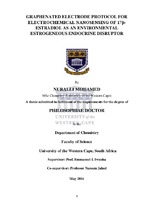| dc.contributor.advisor | Iwuoha, Emmanuel I. | |
| dc.contributor.advisor | Jahed, Nazeem | |
| dc.contributor.author | Mohamed, Nuralli | |
| dc.date.accessioned | 2018-04-03T10:27:29Z | |
| dc.date.available | 2018-04-03T10:27:29Z | |
| dc.date.issued | 2016 | |
| dc.identifier.uri | http://hdl.handle.net/11394/5862 | |
| dc.description | Philosophiae Doctor - PhD (Chemistry) | |
| dc.description.abstract | 17β-Estradiol can be defined as an endocrine disruptor chemical with estrogenic activity, which
can bind to the estrogen receptor in the body and potentially alter the normal physiological
function of the endocrine systems. Estradiol has come into veterinary use both to cure and to
prevent animal infections. But owing to its anabolic properties it is also illegally used in livestock
production for growth promotion purposes. The presence of low concentrations of estrogens in the
environment can cause abnormal sexual development of animals and decrease the average number
of human spermatozoa. Therefore, we must monitor the concentration of estradiol in aquatic
environment to protect the health of humans and animals. Generally, the detection of estradiol
includes the use of high performance liquid chromatography (HPLC), surface plasma resonance
(SPR), gas chromatography (GC), liquid chromatography (LC) and electrochemical enzymelinked
immunosorbent assay (ELISA). Although these techniques are useful, many of them are
expensive and time consuming. | |
| dc.language.iso | en | |
| dc.publisher | University of the Western Cape | |
| dc.title | Graphenated electrode protocol for electrochemical nanosensing of 17β- estradiol as an environmental estrogeneous endocrine disruptor | |
| dc.rights.holder | University of the Western Cape | |

